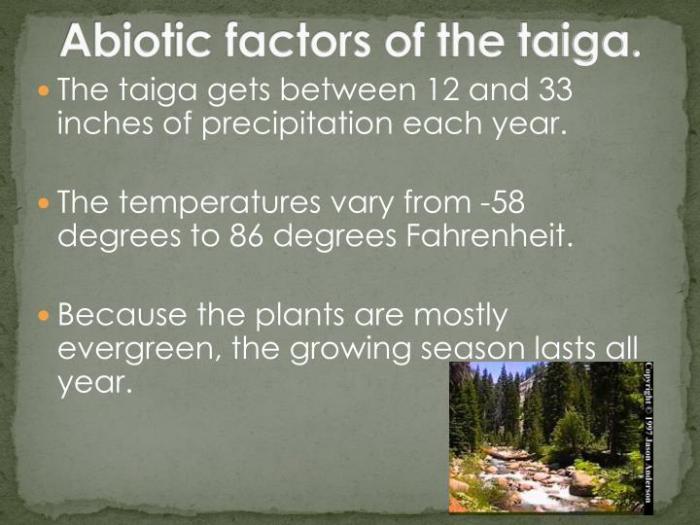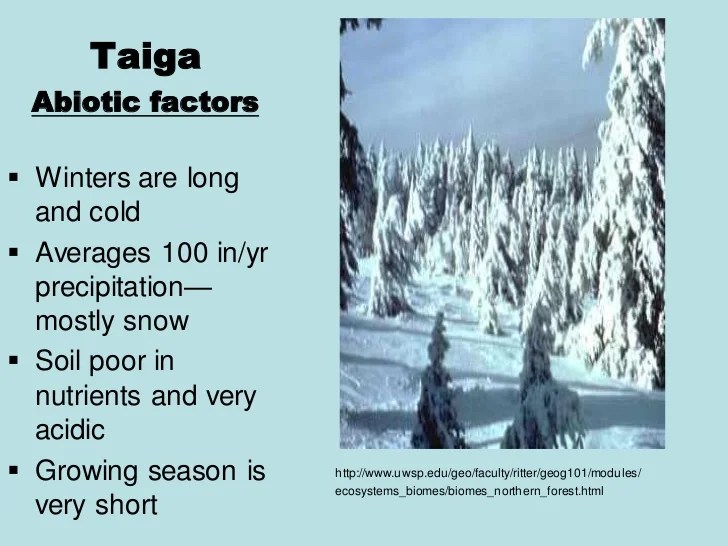Abiotic factors in the taiga biome, a vast and enigmatic ecosystem, play a profound role in shaping its unique characteristics and supporting its diverse life forms. From the frigid temperatures and limited sunlight to the waterlogged soils and nutrient-poor conditions, these non-living components exert a profound influence on the flora and fauna that call this northern realm home.
The interplay of these abiotic factors creates a dynamic and challenging environment, driving the evolution of specialized adaptations and shaping the ecological processes that sustain this remarkable ecosystem.
Abiotic Factors in the Taiga Biome
Abiotic factors are non-living components of an ecosystem that influence the survival and distribution of organisms. In the taiga biome, abiotic factors play a crucial role in shaping the unique characteristics of this cold, coniferous forest.
The taiga, also known as the boreal forest, is a vast biome that encircles the Northern Hemisphere. It is characterized by long, cold winters and short, cool summers, with annual precipitation ranging from 300 to 900 mm.
Climate and Temperature: Abiotic Factors In The Taiga Biome

Temperature is a key abiotic factor in the taiga biome. The average annual temperature in the taiga is below freezing, with temperatures dropping below -40°C in winter. These extreme temperatures have a profound impact on plant and animal life.
Seasonal variations in temperature are also significant. During the short summer months, temperatures can reach up to 20°C, allowing for rapid plant growth. However, the long winter months bring freezing temperatures and snow cover, which can limit photosynthesis and survival for many organisms.
Taiga organisms have evolved adaptations to cope with these extreme temperatures. For example, many plants have thick, waxy leaves that help to reduce water loss and prevent freezing. Animals such as moose and caribou have thick fur that insulates them from the cold.
Water and Precipitation

Water availability is another important abiotic factor in the taiga biome. Precipitation in the taiga is generally low, and much of it falls as snow during the winter months. This snowpack can accumulate to depths of several meters, providing a vital source of water for plants and animals during the spring thaw.
The distribution of water in the taiga is uneven. Some areas, such as bogs and wetlands, are waterlogged during the summer months, while others, such as the drier upland forests, have limited water availability.
The availability of water has a significant impact on the growth and distribution of vegetation in the taiga. Plants that can tolerate wet conditions, such as sphagnum moss and sedges, are common in bogs and wetlands. In drier areas, drought-tolerant plants such as jack pine and black spruce dominate the landscape.
Answers to Common Questions
What is the primary abiotic factor influencing plant growth in the taiga biome?
Temperature and sunlight availability are the primary abiotic factors influencing plant growth in the taiga biome.
How do animals adapt to the extreme cold in the taiga biome?
Animals in the taiga biome have evolved thick fur, layers of body fat, and behavioral adaptations to conserve heat and survive the frigid temperatures.
What is the role of fire in the taiga biome?
Fire plays a natural and essential role in the taiga biome, clearing vegetation, releasing nutrients, and promoting the growth of new plant life.